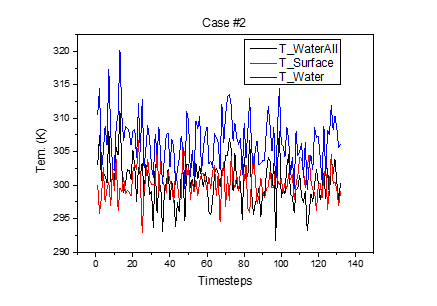Dear LAMMPS Users and Prof. Axel,
In order to realize the poiseuille flow, generally, we build a system
including fluids and medium. In most cases, we only fix the medium and
impose NVT ensemble to fluids. Herein, I am confused about the choice of
ensemble for flexible system.
as has been explained here many, many times. using fix nve or fix nvt does
*NOT* automatically mean, you have an NVE ensemble or an NVT ensemble. with
a flow simulation, you have a non-equilibrium system, so neither of those
ensembles apply (as they require 3d periodicity and no other manipulation
of system forces or velocities to the system outside the integrator).
Basically we have two choices:
1: Just give NVT ensemble to the moving part, and modify the temperature
by water temperature excluding the moving direction, by the following
command
compute Twater water temp/partial 1 1 0
fix 1 movepart nvt temp 300.0 300.0 100.0
fix_modify 1 temp Twater
2. Give NVT ensemble to the flexible underlying medium to control the
temperature, and meanwhile give NVE to fluids .
fix 1 surface nvt temp 300.0 300.0 100.0
fix 2 water nve
which one should be better and physically reasonable?
both have advantages and disadvantages. the closest to an experimental
environment would be a bit more complex variant of your second example.
you partition your surfaces in 3 regions: the region facing the flow is
only time integrated by fix nve, same is the flow; the region to the
outside it not time integrated at all (it has to be thick enough to
resemble bulk), the region in between is thermalized with a dissipative
thermostat (langevin, csld, gle, gld, ...) to mimic the heat exchange with
the missing bulk of the environment.
there is still one slightly unphysical component: the force inducing the
flow in combination with periodic boundaries will generate heat. but if the
force is small enough (i.e. the flow reasonably slow) and after you have
reached a steady state, you should be ok. finite size effects and
limitations of classical potentials, and incomplete statistics are likely
to induce larger errors.
And I have tested these two cases, it seems that the outcome temperature
from the second one gives better results.
making tests yourself and choosing the option that is acceptable for your
needs is the way to go. nobody can make that choice for you. you cannot
write in a paper "some dude on the mailing list told me to do this". either
you can convince yourself and others, that you made the best (or good
enough) choice or you have to find some other approach.
axel.





